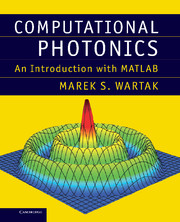Book contents
- Frontmatter
- Contents
- Preface
- 1 Introduction
- 2 Basic facts about optics
- 3 Basic facts from electromagnetism
- 4 Slab waveguides
- 5 Linear optical fibre and signal degradation
- 6 Propagation of linear pulses
- 7 Optical sources
- 8 Optical amplifiers and EDFA
- 9 Semiconductor optical amplifiers (SOA)
- 10 Optical receivers
- 11 Finite difference time domain (FDTD) formulation
- 12 Beam propagation method (BPM)
- 13 Some wavelength division multiplexing (WDM) devices
- 14 Optical link
- 15 Optical solitons
- 16 Solar cells
- 17 Metamaterials
- Appendix A Basic MATLAB
- Appendix B Summary of basic numerical methods
- Index
Appendix B - Summary of basic numerical methods
Published online by Cambridge University Press: 05 July 2013
- Frontmatter
- Contents
- Preface
- 1 Introduction
- 2 Basic facts about optics
- 3 Basic facts from electromagnetism
- 4 Slab waveguides
- 5 Linear optical fibre and signal degradation
- 6 Propagation of linear pulses
- 7 Optical sources
- 8 Optical amplifiers and EDFA
- 9 Semiconductor optical amplifiers (SOA)
- 10 Optical receivers
- 11 Finite difference time domain (FDTD) formulation
- 12 Beam propagation method (BPM)
- 13 Some wavelength division multiplexing (WDM) devices
- 14 Optical link
- 15 Optical solitons
- 16 Solar cells
- 17 Metamaterials
- Appendix A Basic MATLAB
- Appendix B Summary of basic numerical methods
- Index
Summary
In a book like this, the development of computer programs for various tasks and also execution of simulations for different processes and devices, plays an essential role. The fundamentals of many computer programs are supported by numerical methods. Therefore, in this Appendix we summarize main elements of numerical analysis with an emphasis on methods related to the development of programs used in this book, and also to understanding of operation of those programs.
There are many excellent textbooks devoted to numerical analysis. We found the books by Koonin [1], DeVries [2], Garcia [3], Gerald and Wheatley [4], Rao [5], Heath [6] and Recktenwald [7] of significant pedagogical value. The books by Press et al. [8] stand on their own as an excellent source of practical computer codes ready to use.
We concentrate on description and implementation of some practical numerical methods and not on the problems which those methods are typically used for. We start our discussion with a summary of methods of solving nonlinear equations.
There are many textbooks aimed to the introduction of numerical methods and their applications. Some of the most popular are: Applied Numerical Analysis Using MATLAB by Fausett [9], Numerical Methods for Physics by Garcia [3], Introduction to Scientific Computing by van Loan [10], Advanced Engineering Mathematics with MATLAB by Harman et al. [11], A Friendly Introduction to Numerical Analysis by Bradie [12].
- Type
- Chapter
- Information
- Computational PhotonicsAn Introduction with MATLAB, pp. 420 - 447Publisher: Cambridge University PressPrint publication year: 2013



